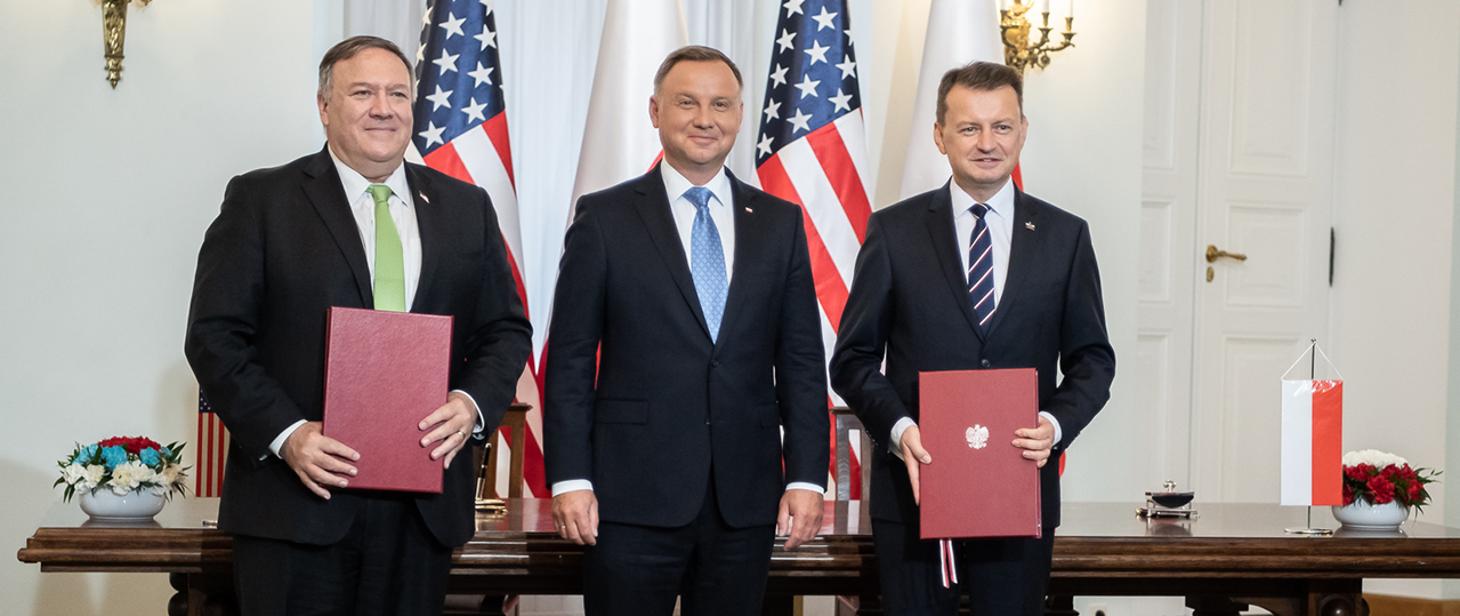
By Matthew Thomas in Policy | December 23, 2020
On November 9, 2020, 31 years after the fall of the Berlin Wall, Polish President Andrzej Duda signed the Polish Senate’s ratification bill of the U.S.-Polish Enhanced Defense Cooperation Agreement (EDCA). This agreement contains a number of provisions that will facilitate greater defense cooperation between the United States and Poland and improve deterrence and battle readiness for NATO along the alliance’s Eastern Flank. For the Baltics, this ratification is welcome news, as it not only improves the regional deterrent posture, but also a number of crucial conditions in Poland to enable more rapid and effective defense in the event of Russian aggression on their territory.
What it Contains
The EDCA is a product of continuing amicable U.S.-Polish bilateral relations and defense cooperation, and contains a number of crucial provisions that will aid NATO’s mutual defense mission on the Eastern Flank, and particularly, in the Baltic theater. These are as follows:
• First, it augments the 1951 NATO Status of Forces Agreement, outlining the legal status of U.S. forces and related personnel in Poland and providing clearance for them to access specific Polish military installations and conduct activities related to mutual defense.
• Second, it supports the expansion of necessary infrastructure for host nation support and logistics, enabling an increased U.S. military presence in Poland. The costs of these improvements will be shared by both countries, with the U.S. continuing to take on the costs of training, equipping, and deploying its troops.
• Third, it establishes an increase in the number of U.S. troops present on rotation in Poland from 4,500 to at least 5,500. This includes the forward elements of the U.S. Army V Corps headquarters and a division headquarters; intelligence, surveillance, and reconnaissance (ISR) capabilities; and along with the necessary infrastructure, will allow for the presence of an armored brigade combat team and a combat aviation brigade.
• Lastly, the provisions for expanded infrastructure will ensure the possibility of immediate deployment of 20,000 additional U.S. troops to Poland in the event of a possible existential threat or crisis.
Presently, the U.S. leads the NATO enhanced Forward Presence (eFP) battlegroup at Orzysz, in northeastern Poland, and deploys an armored brigade combat team there. These new provisions will facilitate the expansion of this cooperation in an essential strategic zone.
Why it Matters
Orzysz is located in the Masurian Lakes region in Poland, about 125 kilometers from the Polish-Lithuanian border by road. The proximity of U.S. forces and the eFP battlegroup in Orzysz to the Suwałki Gap is important for their rapid deployment into the Baltic theater if necessary, and for the defense of the Gap itself should Russia seek to control that zone, cutting off the Baltics from the rest of Europe. The increased troop presence here will strengthen the deterrent provided by the eFP battlegroup and will facilitate preparedness for rapid defensive action. Further, improvements to the infrastructure will provide for greater efficiency in deployment of troops, equipment, and supplies. Likewise, these improvements will build Poland’s capacity to host even greater numbers of troops, leaving Warsaw better prepared for a crisis. This, in turn, adds to the deterrent posture, as an aggressor will not only have to worry about the eFP battalions, but the rapid deployment of tens of thousands more troops.
At face value, clearances and other such personnel related permissions may seem dull and unimportant, but these legal frameworks are critical for efficiency in decision-making. By creating these frameworks, the U.S. and Poland have established the means for answering important questions with access and protocol for both training and conflict situations. In the event of a crisis, these frameworks will ensure that the defenders are able to respond quickly, coherently, and effectively.
The infrastructure component provides another interesting angle vis-à-vis the regional theater: the landscape in that northeastern portion of Poland and across into Lithuania is swampy and thickly forested, and lacks adequate infrastructure to accommodate heavy armored vehicle transport. While that region itself is not a good candidate for armored combat, central Lithuania is, and tank warfare capabilities are a crucial strength for Russia. Thus, it is necessary for the United States to establish an effective means of transporting such equipment into Lithuania. These agreed upon improvements to infrastructure could improve armored mobility to combat the Russian tank threat in Lithuania.
Conclusion
All in all, the EDCA fits well within U.S. security strategy in Eastern Europe, reinforcing continued defense cooperation with Poland and improving the effectiveness of said cooperation. The agreement provides a foundation for growing readiness for conflict by establishing important protocols, building infrastructure and capacity, and increasing troop presence along the Eastern flank and near the strategic Suwałki Gap. This not only provides increased preparedness for war, but establishes a more credible deterrent along a “peace through strength” rationale. By signing and ratifying the EDCA, the U.S. and Poland have made a significant contribution to security along NATO’s Eastern Flank and particularly within the Baltic theater. The Baltics and Poland alike can only hope for continuity in defense cooperation with the United States over the next decade in order to preserve their territorial integrity and independence. Now is not the time for the U.S. to abandon Eastern Europe.
Cover photo: The U.S. Secretary of State, Mike Pompeo, and the Polish Defense Minister, Mariusz Błaszczak, signed the EDCA at the Presidential Palace in Warsaw on August 15, 2020. Credit
